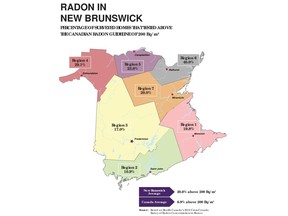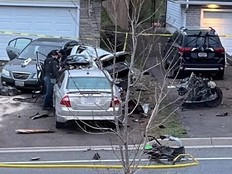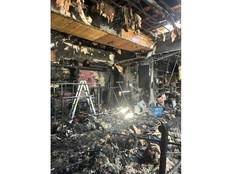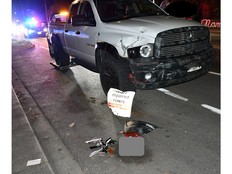N.B. testing for deadly gas jumped by over 300%, data show
About 60 per cent of public housing units have now been checked for radon, province says

Article content
The province ramped up radon gas testing in public housing units by over 300 per cent this winter, new data show, and it’s attributing the dramatic rise to a change of mindset.
About 60 per cent of the 4,506 Public Housing and Rural and Native Housing (RNH) units have now been tested, the province said in an email on Thursday – a dramatically higher number than the 43 per cent it recently told Brunswick News had been completed.
No explanation for the discrepancy has been provided.
There were 1,519 units tested this winter, government spokesperson Kate Wright said in an email on Thursday.
“There were an additional 59 tests done this season, which were re-tests and confirmation tests on remediated units, bringing the total testing number to 1,578,” she said.
That’s more than three times the 481 units tested in the winter of 2022-2023. In 2021-2022, 269 units were tested; in 2020-2021 that number was 297. In the winter of 2019-2020, 116 units were checked for radon.
“Including the new tests administered this season, Housing NB has tested approximately 60 per cent of the province’s public housing units,” Wright said.
“For further context – the tests are administered over a 90-day period and are most appropriately completed during the winter months. The testing window is now closed for the season. The province’s remaining public housing units will be tested in the 2024/25 winter testing season.
“Based on the test results received to-date, there are currently 20 units requiring remediation. These units are planned for remediation this year.”
Radon is created by the natural breakdown of uranium in dirt, rock or water, which can seep into homes through cracks in foundations, walls or floors. After smoking, radon is the leading cause of lung cancer in Canada, accounting for about 16 per cent of all cases, and 3,000 deaths a year. The gas spreads tiny radioactive particles that infect and eventually kill thousands of people in this country every year.
Testing for radon, which is present in all homes at some level, can only be completed in winter, when doors and windows stay closed and the gas builds up. Ventilation from open windows and doors during the rest of the year helps dramatically lower radon levels.
A Brunswick News investigation published in March last year showed that one in every four Public Housing and RNH units tested by the government had returned radon levels high enough to be considered contaminated by the federal government.
The federal guidelines say radon contamination occurs when a home tests higher than 200 Becquerels per cubic metre (200 Bq/m3). The highest reading detected in New Brunswick between 2017 and 2022, according to the government, was more than 27 times over the 200 Bq/m3 limit.
The investigation also found that the province underspent its budget for radon gas testing and remediation in social housing units by hundreds of thousands of dollars in the 2020/2021 and 2021/2022 fiscal years, despite the auditor general’s call to ramp up efforts because of the potential health risk to tenants.
The province blamed the pandemic, and the restrictions on movement it caused.
How long it takes for radon to start affecting people’s health depends on the concentration of gas in the home. It’s a long-term problem, not an immediate one. Therefore, the urgency to fix the problem escalates based on the size of the reading in each home.
Documents obtained by Brunswick News during the investigation also showed:
- Radon levels well beyond what the federal government considers safe have been detected in occupied Public Housing units in Miramichi, Saint John, Lameque and Edmundston;
- New tenants have been moved into units with higher-than-acceptable radon levels, and where no remediation work has been done;
- Some radon tests performed by qualified contractors were done incorrectly, invalidating the results. Some others were invalidated by tenants who tampered with the test kits;
- Senior civil servants complained internally about a lack of qualified contractors to complete radon work, then later admitted they don’t definitively know how many people are qualified to do the work;
- An offer of help from Ottawa was initially rebuffed, with New Brunswick officials commenting privately to each other that they had “a good handle” on the situation, and;
- An internal question in December 2020 about doubling the yearly budget for radon work from $600,000 to $1.2 million was rejected in favour of a $150,000 boost.
A couple of months after the investigation was published, Minister Responsible for Housing Jill Green said the government’s radon gas testing “philosophy has changed,” and pledged to drive improvement. In the legislature in May, Green was confident all public housing units would be tested this winter – a goal that wasn’t achieved.
In response to two interview requests, the government told Brunswick News that Green was not available.












Postmedia is committed to maintaining a lively but civil forum for discussion. Please keep comments relevant and respectful. Comments may take up to an hour to appear on the site. You will receive an email if there is a reply to your comment, an update to a thread you follow or if a user you follow comments. Visit our Community Guidelines for more information.